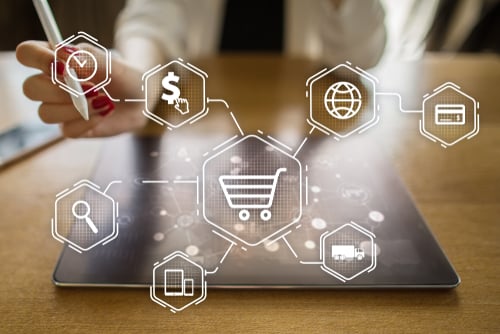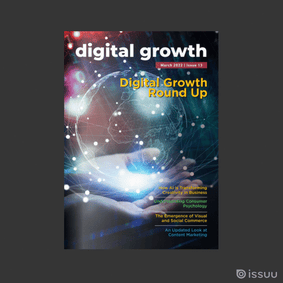In order for your e-commerce business to grow, you need to understand your target market and get to know your customers. It's therefore vital for long-term success, that e-commerce businesses organize, segment and use their data as efficiently as possible in order to provide both access to data for marketing and sales campaigns as well as insights that can drive strategy.
Your customers actually provide a lot of insight every single time they interact with your website, whether they are clicking through to your store via a social platform or they found your product through Google search, their activity helps give your marketers and sales team a lot of valuable information that you can use to your business advantage and to give your customers the experience they are looking for.

By connecting a platform such as HubSpot to your e-commerce site, you will be given the tools to help you make sense of this information and you will also be given the tools you need to engage with your customers and sell to them in a more streamlined way. The marketing tools that are available through HubSpot will help you deliver the correct message to the correct person at the ideal time.
Below, we outline how you can use HubSpot Customer Relationship Management (CRM) for your e-commerce business:
Sync your e-commerce customer data and integrate your platforms
What makes HubSpot’s Customer Relationship Management so effective for e-commerce businesses is that it offers you the opportunity to understand your customers buying patterns - and helps you act on these patterns. You are also able to implement automated marketing campaigns, track your progress and report on all your revenue streams through HubSpot’s e-commerce marketing dashboard.
So, how do you connect HubSpot to your e-commerce store, and is this easy to implement?
Your e-commerce site probably runs through a platform like Shopify or Magento, and these platforms will host your checkout flow, product pages and your order history, and they are also designed to provide your customers with an efficient shopping experience. These platforms connect directly to HubSpot so you do not have to worry about integration.
By connecting your e-commerce platform to HubSpot you will quickly grow your online store as you are given the tools to attract and convert your customers while providing them with an exceptional user experience. Connecting your e-commerce store to the HubSpot platform couldn't be easier. HubSpot has a native integration with Shopify, which means that just a simple few clicks can connect your Shopify platform to a whole new world of sales and marketing opportunities. For other e-commerce platforms, HubSpot's E-commerce Bridge allows simple connectivity through pre-defined APIs and if you're not sure if you can connect platforms yourself, speak to a HubSpot partner agency such as Nexa, and we can help.
The e-commerce flywheel
We have all heard of the sales funnel and your business is probably using the tactic to generate leads, but for those who are unsure of what it is, the sales funnel refers to the journey that the customer goes through in order to make a purchase.
The sales funnel has been what marketers and salespeople have been using to source leads for years, however online shopping has changed this journey. Today’s online consumer is smarter than ever and looks at a variety of things before making a purchase, including reviews, customer feedback and word of mouth. The statistics speak for themselves: 90% of today's consumers are influenced by customer ratings online and 87% say that social media plays an important part in their shopping decisions.
With this shift in buyer behavior, a new way to generate leads has emerged and this is known as the Flywheel as opposed to the Funnel.
A flywheel is a mechanical device that stores rotational energy and the energy the flywheel manages to contain affects how fast it will spin - the amount of friction applied to it and its size also affects how fast it rotates.
When you apply this concept to e-commerce, a flywheel places customers at the centre of the spinning process, it is customers who keep the momentum of the spin going. Satisfied clients who make consistent purchases, share their purchases online and make recommendations will add more speed to the flywheel. Essentially - your customers and their engagement with your business will keep your business moving. Think about it like this, the sales funnel has a beginning and ends as a client makes a purchase, whereas the sales flywheel keeps going, as a satisfied client has the ability to introduce your business to their online networks and increase sales opportunities.
However, in order to get your customers to keep your flywheel spinning, you need to apply “force” and this is done through marketing tactics that are designed to attract, engage and satisfy the customer. These marketing tactics are made up of a variety of communication tools, from social media campaigns and email campaigns to content marketing, sales outreach and more. When all of these tactics work together, your flywheel will undoubtedly keep spinning.
So, where do you turn in order to keep the momentum going? HubSpot CRM of course.
Finding the right customers
HubSpot sets the standard for inbound marketing, but that is not all the platform can do. The platform provides a CRM, Marketing Hub, Sales Hub as well as a Services Hub, and gives you a single place where you can store and organise your customer data and transactions, while providing you with the tools to create marketing campaigns and more in order to grow your business.
The software also helps you build the e-commerce flywheel we touched on above, for example, it will track when your customers clicks on a social media advert, fills out a lead form on your website and purchases a product - and if they share that purchase on their social media platforms.
By having access to such in-depth data, you can personalise the buying process, helping you identify certain buyer behaviors, and customise your sales and marketing approaches to suit these specific behaviours. For example, you will be able to see where potential customers are abandoning their online shopping cart, and with this information you can reduce any friction by launching re-engagement campaigns with these potential customers to get them back on the site and make their purchase.
How to use the HubSpot Marketing Hub for E-commerce Businesses
Now that you know what your e-commerce website can get from HubSpot CRM and you have pinpointed your opportunities through the data provided - you are able to implement the best marketing strategies to get your flywheel spinning.
The HubSpot marketing hub is where you will create your content and campaigns to attract visitors, generate leads and nurture these leads in order to convert them into paying customers. The HubSpot marketing hub offers a variety of tools to help you build an engaging website and direct visitors to your site and you are able to use all of these tools to create a brilliant experience that makes it simple for visitors to find your website, engage with your content, and keep them coming back to your e-commerce site for more.
HubSpot and Social Media
Social media is vital to any marketing strategy as it is the place where you can attract, engage and delight customers the most. This is because social media is where your target market is, with over 2.5 billion people using social media, it goes without saying that your audience will be there. However, you can’t simply be on social media, you need to engage with your audience on your social media platforms. If a consumer has a positive interaction with your business via your social media pages, they will trust your brand and recommend your business to others.
HubSpot seamlessly integrates with all your social media platforms and you are able to publish content to your social media pages through the platform and you are able to track the success of all your social media efforts. The social media analytics provided by HubSpot will give you insight into how your customers move from your social media to your e-commerce site, and with this data you are able to see what is working and what needs to be changed - and where your customers are dropping off in the buyer’s journey.
Blogging
A blog is one of the most important parts of digital marketing and is a big part of inbound marketing. This is because a blog contains helpful information which keeps users on your site and it gets your website ranking on search engine results. HubSpot comes with a native blogging engine that can help you create and publish blogs easily to your website - and users are able to share your blog to their social pages as well.
Another tool to keep your flywheel spinning!
Landing Pages
HubSpot makes it simple for you to create landing pages and this process does not require coding. What makes these landing pages so effective is that they come with a great deal of customisation and this creates a more personalised and targeted landing page. So, what does this mean? Your landing page can be configured to show different content to different audiences and this makes for greater lead generation as you are speaking to where your potential customer is at in their buying journey.
Remember that your landing page is a place to create a valuable and quick interaction between your business and a page visitor and your visitor should be able to fill out a form on this page as quickly as possible.
Search Engine Optimisation
Search Engine Optimisation (SEO) is the process used to get your website ranking in the search results pages for relevant keywords related to your business.
Content and SEO work together and this is why HubSpot marketing Hub is designed with SEO in mind and it is seamlessly integrated into all of their content creation tools - from blogs to landing pages.
Learn more about SEO and why you need it for your e-commerce site, here.
Lead Generation with HubSpot
Now that you have marketed your e-commerce site, how do you successfully convert visitors into leads?
HubSpot offers the following:
- Leadflows: This is a custom pop up form that you can create through HubSpot that will be activated as a customer visits a certain target.
- Forms: This is a simple but highly effective tool and gives you the ability to create customised forms designed to convert a new visitor into a contact. These forms can be used when a visitor signs up for a newsletter, or downloads an e-book etc. They will have to fill out the form with their details in order to receive something - also known as a lead magnet and this is a great way to collect relevant data for your sales team and gives you the opportunity to continue communication with them, via email or remarketing campaigns etc.
- Chatbots: Customer satisfaction is key on e-commerce sites and in order to provide a greater user experience for your customers, you need to offer them instant communication. HubSpot offers chatbots that pop up on your website, where customers can ask questions and get immediate feedback - which is an incredible support function and is always appreciated by users. You also collect customer information through chatbots, making for excellent lead generation.
Learn more about lead generation with HubSpot, here.
Nurturing E-Commerce Leads with HubSpot
Once you have collected valuable lead information, you can nurture your leads through HubSpot.
HubSpot offers the following:
- Marketing Automation: Workflows are a brilliant tool for automating important marketing outreach activities. With HubSpot's email marketing editor you are able to design email templates that take data from your contacts, and personalise them - and send the relevant emails to your leads. Each lead will receive an email that is relevant to where they are in their specific buyer’s journey, and your sales team will also be notified if the lead has taken the desired action from the email so that they can follow up on the sale.
- Email Marketing: As stated previously, HubSpot can automate marketing processes and your email marketing can be completely automated. Email marketing through HubSpot is incredibly advanced and no other platform can compete with its segmentation and automation features. Essentially, there are a few tools that will help you divide your audience into specific metrics and data points and you will be able to send out email chains that are completely personalised to your individual lead or customer to ensure an increase in sales.
In Conclusion
If you want to gain more leads, convert leads into clients and keep your sales flywheel turning, then HubSpot is the platform for you. HubSpot is a valuable asset for any business and we are here to help you optimise it to reach its full potential.
Nexa is proud to be a Diamond-tiered HubSpot Partner and this places us in the top 2% of HubSpot Partners globally.
If you are interested in implementing HubSpot for your e-commerce business, our HubSpot development team has experience integrating HubSpot's CRM with a number of platforms that can increase the efficiency and data access for your business. In fact HubSpot integrated with over 500 other software titles to help your team streamline activities and in doing so increase efficiency and productivity. Contact us today for more information and to learn more about our offerings.
%20(1).png?width=2701&height=607&name=BRC_NEXA_LOGO_BLACK%20%26%20VIOLET%20(1)%20(1).png)
%20(1).png?width=2701&height=607&name=BRC_NEXA_LOGO_WHITE%20(2)%20(1).png)















Comments